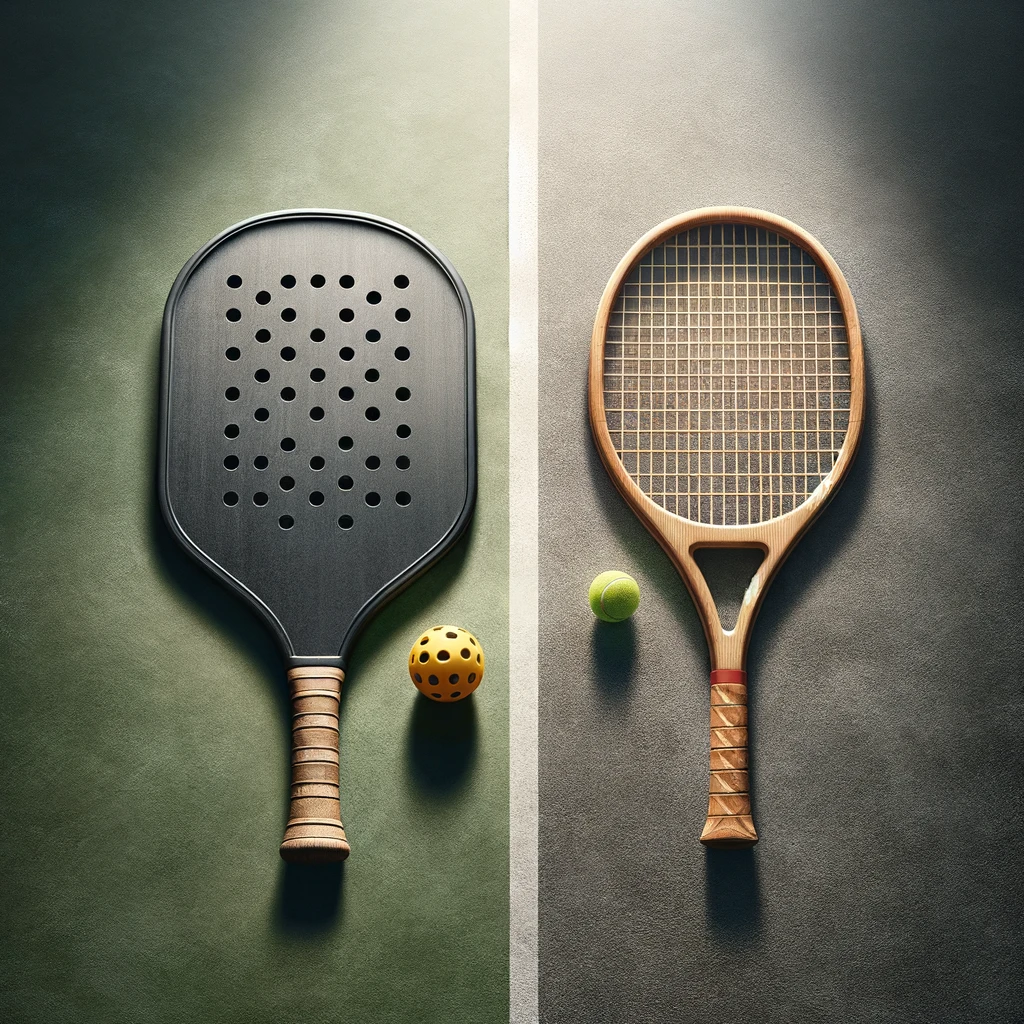Delving into the intriguing world of racquet sports, we’re faced with a captivating question: Is pickleball louder than tennis? This inquiry, more complex than it appears, depends on a myriad of factors including the equipment used and the playing environment. Sound level tests reveal that pickleball, with its distinctive clack, tends to produce slightly louder noises than tennis, reaching up to 55 decibels, compared to tennis’s quieter 45 decibels. The materials of the paddles and balls play pivotal roles in this auditory difference.
Pickleball’s unique sound signature can be attributed to its hard material paddles, such as graphite or composite, striking a plastic ball, in contrast to the softer sounds produced by tennis rackets made of materials like wood. This difference in equipment, alongside the sport’s dynamics, such as smaller courts and the intensity of play, amplifies pickleball’s volume, making it a more noticeable presence on the court.
This comparison not only highlights the distinct acoustic footprints of pickleball and tennis but also opens the door to a deeper understanding of how equipment and gameplay influence the sounds of sports. Through examining these aspects, we gain insight into the nuances that define the auditory experience of each game, setting the stage for further exploration into the world of racquet sports.
Basics of Pickleball and Tennis
Court Comparisons
Pickleball courts are noticeably smaller than tennis courts, which significantly influences the pace and strategy of the game. Measuring 20 feet in width and 44 feet in length, pickleball courts demand less ground to cover, allowing for quicker exchanges and more engaging play. In contrast, tennis courts stretch 36 feet wide and 78 feet long, demanding greater physical endurance and strategic positioning. Furthermore, the net height varies between the sports – pickleball nets stand at 36 inches high, compared to tennis nets which are 42 inches high at the center. This lower net in pickleball facilitates a variety of shots, such as the dink shot, adding a layer of tactical depth to the game.
Equipment Differences
The gear used in each sport further distinguishes pickleball from tennis. Pickleball players wield paddles made from wood or composite materials, characterized by their smaller size and shorter handles compared to tennis rackets. The ball in pickleball, made of plastic with smaller holes, contrasts with the felt-covered, pressurized tennis ball, which is designed for higher bounce and speed. These equipment differences not only affect the ball’s movement and players’ interactions with it but also contribute to the distinct playing experiences of each sport.
In terms of gameplay, both sports offer doubles and singles formats, but with a twist in pickleball: regardless of the format, the court size remains unchanged, challenging players to adapt their strategies accordingly. This aspect of pickleball encourages versatility and quick thinking, as players must navigate the same space whether engaging in singles or doubles play.
Exploring the fundamentals of pickleball and tennis reveals the thoughtful design and rules that cater to the unique appeal of each sport. Whether drawn to the swift, strategic gameplay of pickleball or the endurance and breadth of tennis, players find in each game a rich blend of physical challenge and tactical depth. As we delve deeper into the nuances of these sports, we uncover the intricacies that not only differentiate them but also celebrate the diversity and vibrancy of racket sports as a whole.
Sound Characteristics in Sports
Measuring Noise Levels
The Environmental Protection Agency (EPA) has set the maximum average outdoor noise level at 55 decibels, a standard that helps gauge the auditory impact of various activities, including sports. In the comparison between pickleball and tennis, it’s noteworthy that pickleball often registers louder on the decibel scale. Measurements indicate that the sound of a pickleball being hit can reach up to 55 decibels, aligning with the EPA’s limit, whereas tennis typically produces a lower sound level around 45 decibels. This difference highlights the distinct acoustic profiles of the two sports, suggesting that pickleball may offer a more robust sound experience.
Factors Affecting Noise
The noise level in sports is significantly influenced by the equipment and the ball used. Pickleball utilizes a hard plastic ball, which contributes to its characteristic sharp, higher-pitched sound upon impact. This contrasts with the more subdued thud-like sound produced by the felt-covered rubber ball used in tennis. Additionally, the design of the paddles and rackets plays a crucial role in the sound generation. Pickleball paddles, typically made from wood or composite materials, have a solid face that amplifies the sound of the ball strike. In contrast, tennis rackets feature a strung surface that can dampen the sound, leading to a quieter impact noise.
This exploration into the sound characteristics of pickleball and tennis reveals the nuanced ways in which equipment choices and design considerations shape the auditory landscape of these sports. The distinct sounds of pickleball and tennis not only differentiate them but also enhance the sensory experience of the games, adding an extra layer of engagement for those who play and watch. As we delve further into the specific attributes of each sport, we gain a deeper appreciation for the intricate details that contribute to their unique identities.
Comparative Noise Levels of Pickleball and Tennis
Pickleball Noise Factors
Pickleball is known for its vibrant sound, largely due to the hard paddles and the plastic balls used in the game. These materials create a pronounced noise upon impact, further amplified by the typically hard court surfaces where the game is played. Innovations like “quiet paddles,” crafted from composite materials, have been introduced to mitigate the sound, offering a less noisy playing environment. The distinct clack of pickleball serves not just as a part of the game’s character but also as a point of consideration for players seeking quieter play options.
Tennis Noise Factors
Tennis, with its own set of auditory characteristics, generates sound through the interaction of the felt-covered ball and the racket. The nature of the court surface plays a significant role in the acoustics of the game; hard courts tend to elevate the noise level compared to the softer, more dampening effect of clay or grass courts. This variation in sound contributes to the unique atmosphere of tennis matches, distinguishing between the different playing surfaces.
Decibel Levels of Pickleball and Tennis
Measurements using sound level meters reveal that pickleball can reach noise levels up to 55 decibels, aligning with the Environmental Protection Agency’s (EPA) maximum average outdoor noise guideline. Tennis, on the other hand, typically registers around 45 decibels, positioning pickleball as the louder of the two sports by about 10 decibels. This discrepancy can be attributed to the equipment and court sizes specific to each sport. For those sensitive to noise, protective measures such as earplugs or noise-cancelling headphones can enhance the playing experience, ensuring a comfortable environment regardless of the sport’s inherent noise level.
This comparative analysis underscores the importance of sound in shaping the experience of racket sports. While pickleball and tennis each offer unique auditory profiles, understanding and managing their noise levels can contribute to a more enjoyable and inclusive playing environment for everyone involved.
Cultural and Social Impact
Popularity and Growth
Pickleball’s universal appeal lies in its simplicity and the ease with which beginners can engage, making it an inclusive option for individuals across all ages and skill levels. Its adaptability to both indoor and outdoor settings enhances its versatility, allowing for year-round play irrespective of weather conditions. This accessibility has spurred a remarkable surge in popularity, culminating in the establishment of Major League Pickleball, a testament to the sport’s escalating professional stature. Beyond the courts, pickleball has catalyzed the formation of vibrant communities, uniting players in a shared passion and fostering a profound sense of belonging and camaraderie.
Community and Accessibility
The essence of pickleball’s impact lies in its unparalleled accessibility. With minimal equipment and space requirements, it stands as a beacon for inclusivity, inviting those who may be alienated by the complexities and demands of traditional racket sports. This accessibility extends across generational divides, making it a unifying force that bridges age gaps and cultural differences. Particularly noteworthy is its adoption among the senior population, for whom pickleball offers not only a form of physical exercise but a vibrant social outlet, promoting well-being and connectivity among older adults.
Pickleball’s cultural and social influence is undeniable, with its ability to knit together diverse communities through the simple joy of play. It represents more than just a sport; it is a movement that champions inclusivity, health, and social interaction, making a lasting impact on the fabric of society. Through pickleball, individuals find not only a recreational activity but a community and a sense of belonging, underscoring the sport’s role in shaping a more connected and active society.
Mitigating Noise and Enhancing Experience
Court Surface and Materials
The selection of court surfaces plays a pivotal role in sound absorption. Hard surfaces like concrete and asphalt amplify sound vibrations, making the game louder, whereas softer surfaces such as clay or grass naturally dampen noise, offering a quieter playing environment. For those seeking to further reduce noise impact, installing sound barriers around the court can be an effective solution. Options range from acoustic panels and fencing to natural barriers like vegetation, each serving to contain and absorb sound, thus minimizing its spread to surrounding areas.
Equipment Innovations
Advancements in equipment design offer another avenue for noise reduction. Quiet paddles, engineered to absorb sound, can significantly lower the decibel levels produced during play. These paddles often feature a thicker construction, further aiding in noise mitigation. Similarly, opting for thicker balls can also result in a quieter game, as they absorb more impact sound than their thinner counterparts. Manufacturers are increasingly recognizing the demand for quieter play, leading to the development of balls specifically designed to reduce noise, thereby enhancing the playing experience for both participants and onlookers.
These strategies not only contribute to a more pleasant and less disruptive pickleball or tennis session but also foster a more inclusive environment, allowing the sports to be enjoyed in closer proximity to residential areas without concern for noise pollution. By considering court surfaces, sound barriers, and equipment innovations, players can effectively balance the intensity of the game with the need for tranquility in communal spaces.
Conclusion
The question “Is Pickleball Louder Than Tennis?” has led us on an enlightening journey through the auditory landscapes of these beloved sports. Our exploration has confirmed that, indeed, pickleball tends to produce higher decibel levels than tennis, attributed to the distinct materials of the paddles and balls, as well as the dynamics of play. This investigation into the comparative noise levels not only sheds light on the physical aspects contributing to the sound produced by each sport but also underscores the significance of considering the auditory impact on players and surrounding communities.
Addressing the sound concerns inherent in pickleball and tennis, we’ve delved into strategies for mitigating noise, from choosing softer court surfaces to adopting equipment innovations designed to lower decibel outputs. These solutions highlight the sports community’s commitment to balancing the passion for the game with mindfulness towards environmental and social harmony. As pickleball continues to grow in popularity and tennis maintains its esteemed status, the dialogue around noise levels emphasizes the importance of adaptability and respect within the sports, ensuring they remain accessible and enjoyable for all.

